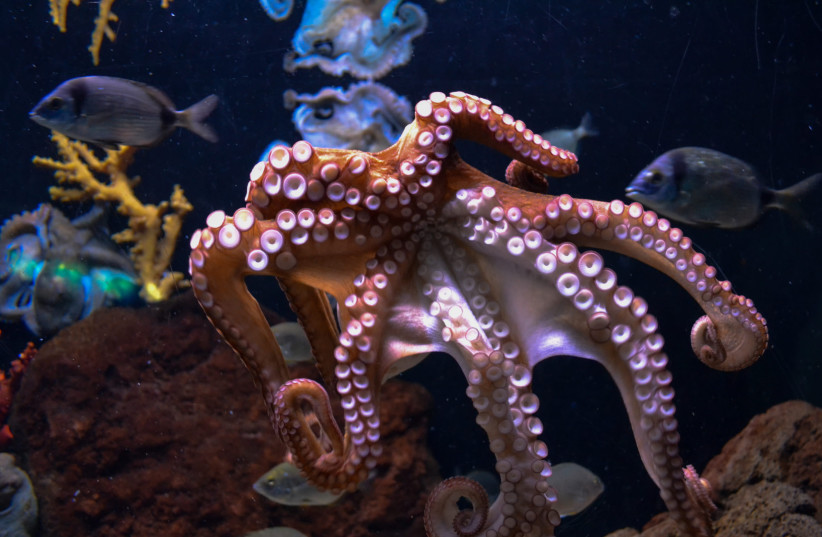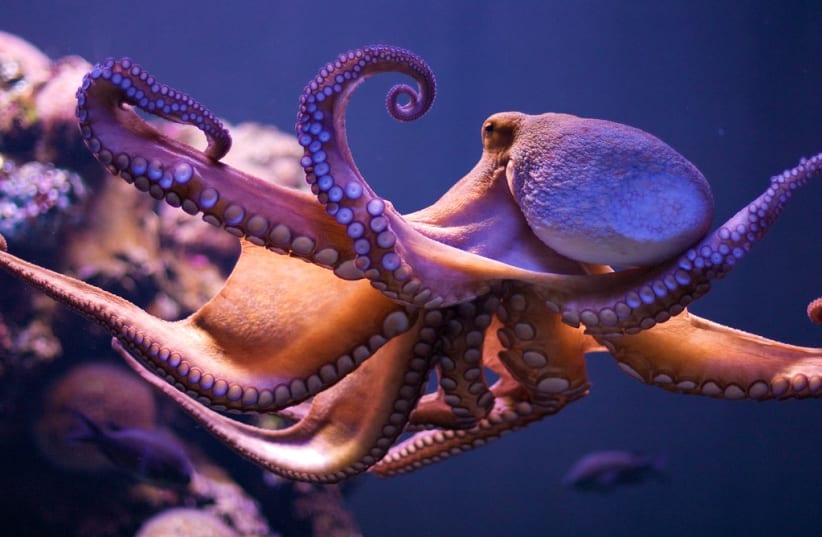The octopus not only has eight arms, this soft-bodied mollusc with two eyes and a beaked mouth in the center has a lot of brainpower. Prof. Benny Hochner of the Institute of Life Sciences at the Hebrew University of Jerusalem and Prof. Jeff Lichtman of Harvard University in Boston and their teams have uncovered the neural architecture governing the learning processes of the mysterious common octopus (Octopus vulgaris).
They said their findings present a promising model for studying memory networks and could enhance our understanding of cephalopod cognition and memory processes through a comparison with other animals, including humans.
They have just published their work in the journal eLife under the title “Connectomics of the Octopus vulgaris Vertical Lobe Provides Insight into Conserved and Novel Principles of a Memory Acquisition Network.”
Separated from humans by 700 million years of evolution, octopuses have cognitive abilities rivaling even higher vertebrates. The octopus is the last common ancestor of cephalopods (animals whose name from the Greek means “head foot,” which perfectly describes animals that have eyes just above their many limbs, including the squid, nautilus, and cuttlefish).
They existed with vertebrates more than 500 million years ago and provide a unique opportunity to study the independent evolution of nervous systems subserving sophisticated cognitive abilities. The researchers focused on the vertical lobe of the octopus’s central nervous system, which is crucial for learning and memory. They aimed to compare neural networks and mechanisms across species.


What did the study reveal?
The team leveraged innovative automated tissue preparation and new machine-learning reconstruction algorithms. This cutting-edge technology made possible the cutting and sorting of ultrathin sections, each just 30 millionths of a millimeter thick and constructing a three-dimensional representation of the structural elements that comprise the network.
“Our previous studies revealed a fascinating phenomenon of long-term synaptic strengthening (long-term potentiation, or LTP) even within the vertical lobe of the octopus,” Hochner wrote. “This phenomenon, recognized as a universal synaptic process essential for learning and memory, caught our attention. We meticulously charted the connectivity of the vertical lobe using the precision of an electron microscope, achieving a resolution on the order of about 4 millionths of a millimeter.”
The joint team engineered a robotic system with a sophisticated computational algorithm that was uniquely capable of organizing hundreds of ultrathin sections – each only 30 millionths of a millimeter thick – into a comprehensive 3D structure.
“This innovative approach enabled us to trace the connectome – namely, the intricate synaptic connections among the neural elements composing the network,” the study said.
Led by Hebrew University postdoctoral researcher Dr. Flavie Bidel and Dr. Yaron Meirovitch from Harvard, a tiny amount of tissue representing the vertical lobe was meticulously reconstructed to unveil the connectome, which is a comprehensive map of neural connections in the brain and may be thought of as its “wiring diagram.”
An organism’s nervous system is made up of neurons that communicate via gaps called synapses. By applying advanced machine-learning algorithms and precise annotation, the researchers charted the wiring of the vertical lobe in octopus brains. This challenged established notions of neural-network functionality in the context of learning and memory. Unlike typical models, the vertical lobe’s network operates in a feed-forward configuration, like a one-way street, with information only from the input neurons to output neurons that control octopus behavior.
Central to this simplicity is the organizational structure of approximately 25 million interneurons that are divided into two distinct groups – simple amacrine cells (SAMs) and complex amacrine cells (CAMs). The SAMs, numbering around 23 million, specialize in learning visual characteristics through synaptic reinforcement. In contrast, the CAMs, totaling approximately 400,000, play a pivotal role in consolidating activity levels.
The two types of cells send their axonal branches to connect with bigger cells in the output layer. Simple cells, which transmit “learned” information, make the big cells active, while complex cells make them less active, controlling how the brain works efficiently.
This evolutionary adaptation underscores the octopus’s unique cognitive prowess, contributing to scientists’ understanding of neural mechanisms important for cognitive functions. The research revealed that Octopus vulgaris is an invaluable model organism for in-depth exploration of memory acquisition networks and opens doors to further unraveling the intricacies of cephalopod cognitive processes, enriching our understanding of memory across various species.
“In this important study, neural circuit architecture within a brain module for learning and memory in the octopus was mapped from volume electron microscopy,” the journal editor wrote, adding that the “results will serve as the basis for further studies on the fascinating cephalopods and inspire further exploration in the design of artificial neural networks.”
